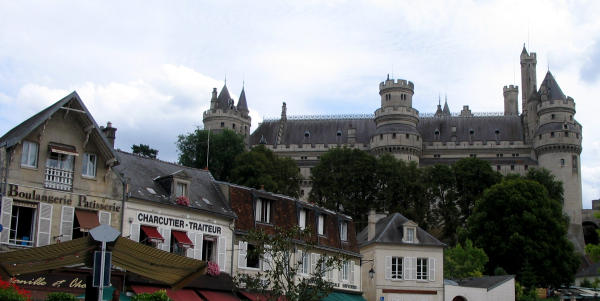
Within an hour’s train ride from Paris, many cycling routes—easy, moderate and knock-yourself-out—allow for a simple-to-organize day of biking and touring. The daytrip described here involves a visit to the town of Compiegne and biking through the forest between the Palace of Compiegne and the Castle of Pierrefonds, with the possibility to add a detour to the Glade of the Armistice.
Little to no planning is required other than knowing where to rent bicycles if you don’t have one of your own. Trains in most directions are frequent enough that you don’t even have to worry much about timing your departure (unless there’s a strike). Many trains outside of rush hour (you’ll be going in the opposite direction) accept bicycles in a special compartment.
The biking route
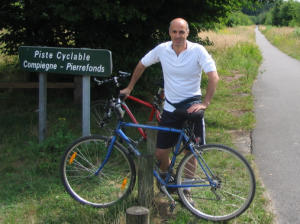
The heart of this daytrip is a 9-10-mile ride in each direction through the Forest of Compiegne between the palace of Compiègne and the castle of Pierrefonds. These two notable sights are connected by two major routes through the National Forest of Compiegne, with many possible detours.
The forest covers about 35,000 acres, much of it former royal hunting ground. The landscape is fairly flat with a few minimal rises. Most of the paths you’ll ride on are paved. The forest is thick with oak and beech, and perhaps you’ll glimpse a deer or a boar or a roe. Roe are small European deer, like the original Bambi (created by an Austrian), which Disney transformed into a North American mule deer.
Of the major biking routes, the southern route through the forest allows for a stop in the village of Saint Jean aux Bois, with its abbey church and picturesque houses, while the northern route goes by the village of Moulins, with its church. I recommend starting with the southern route then taking the northern route on the return since that would then allow you to make a last-minute decision to make a 3-mile detour to the Glade of the Armistice, time and biking energy permitting. The glade is a clearing on the northern edge of the forest where the armistice ending combat of the First World War was signed. Add to this a mile’s ride from the Compiègne train station to/from the edge of the forest and you get a cycling day of 20-25 miles, depending on your route. It’s therefore a moderate ride, and for those with athletic teens a family-friendly daytrip.
How much time you spend visiting the three major sights on this route, or simply admiring them from the outside, is up to you.
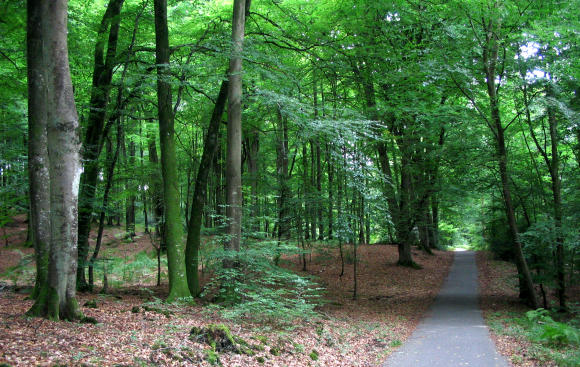
This biking map can be downloaded. Your point of departure, the Compiègne train station (Gare SNCF), is at the upper left of that map.
Here’s a wider view of the region:
The train from Paris
The train between Paris’s North Station (Gare du Nord) and Compiegne takes 48 to 75 minutes, with departures every hour or so. Tickets are about 31€ round-trip. They can be purchased online, at any train (not metro or RER) station or at the North Station at the last minute. I can’t guarantee that they’ll be available at the last minute, but these trains tend not to fill outside of rush hour (you’ll be going in the opposite direction) and special events in Compiegne, unless a conductors’ strike causes everyone to pile onto the one running train. The schedule for specific days can be searched on the site of the French railways company SNCF. Trains idled due to strike are generally indicated as such a day in advance.
If you’ve rented a bike in Paris or have your own, then you’ll need to know which trains have a bike compartment. In that case, look for the appropriate indication in the pull-down tab describing each departure.
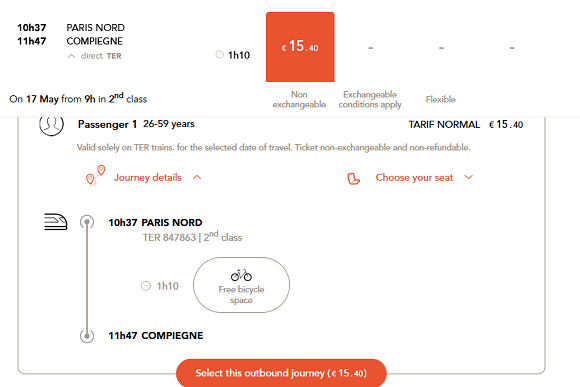
As you arrive at the track, you’ll see a bicycle symbol on the appropriate wagon, but don’t hesitate to ask if you don’t see it. Communication tip for those who don’t speak French: Find a train official on the track, say “Bonjour, excusez-moi,” point to your bicycle then to the train. A shrug of the shoulders and the monkey-like sound où, meaning where, ought to get you pointed to the right compartment.
Bike rental in Compiegne
It’s easy to rent bikes in Compiegne through the rental company Picardie Forêts Vertes, operated by Vincent, with whom you can write to or speak with in English. The booking process and other details are explained in English on the website. Vincent encourages people to reserve their bikes 48 hours or more in advance, but he can often accommodate requests made less than 24 hours in advance, particularly on weekdays. You’ll also make arrangements to drop off the bikes at the end of the day.
A VTC or VTT can be rented for 20€ per day, an electric bike for 25€. Tandems, baby seats and trailers for small children are also available. Helmets, locks and maps are provided. Bring an ID as a deposit. Though the typical rental season runs April through October, you may also contact Vincent in advance about rentals during the off-season.
Compiegne also has an inexpensive bike-share system called Vélotic, with a bike station at the train station. Rentals are 2€ for two days.
Lunch options
I’m not much of a planner when it comes to a short ride involving two towns, as with this ride. You can always find a bakery and cafés in Compiegne and Pierrefords, wherever hunger strikes. My own preference is to purchase a sandwich or more from a bakery in Pierrefonds or have lunch in a café there. If you’re more of a planner you can bring a picnic from Paris or purchase picnic goodies at the center of Compiegne. Or if you set out late in the morning from Paris you enjoy a café or restaurant lunch in Compiegne before setting off through the forest for the afternoon. The Palace of Compiegne also has a nice tea room. Bring along water for the ride in any case. On your return to the heart of Compiegne at the end of the day you might stop into a bakery and chocolate shop to reward yourself for a ride well done.
Sightseeing and touring
There are three notable sights to see along this route: the Palace of Compiegne, the Castle of Pierrefonds and the Glade of the Armistice. You’ll have a fine biking day without going inside any of these, but each is worthwhile and informative should you decide to enter.
The palace is closed Tuesdays and the castle is open daily. Both are closed Jan. 1, May 1 and Dec. 25. The glade is open daily but if making this your final stop note that last admission is at 5:30PM for a 6PM closing. They’re all open daily, except for some holidays. See their respective websites for more schedule details.

As a town with a major palace, Compiègne itself makes for a pleasing daytrip from Paris even if you aren’t interested in biking. So if there are any non-bikers in your travel group they can train out to Compiegne with you and pleasantly live their own touring lives as the others go out biking. The center of town is a 10-minute walk on the opposite side of the Oise River from the train station.
Crossing the bridge you might notice to the right the ruins of a tower now (sometimes) called the Joan of Arc Tour since it existed at the time of Joan’s downfall. On May 23, 1430, having come to help defend the Compiegne from attack by the Bungundians, she was captured and eventually sold to the English and taken to Rouen, where she was tried, condemned and burnt at the stakes. That history—and the late 19th-century inclination to honor it—explains the statue of Joan on the town’s central square in front of City Hall. A local Joan of Arc festival is held the second to last weekend in May.
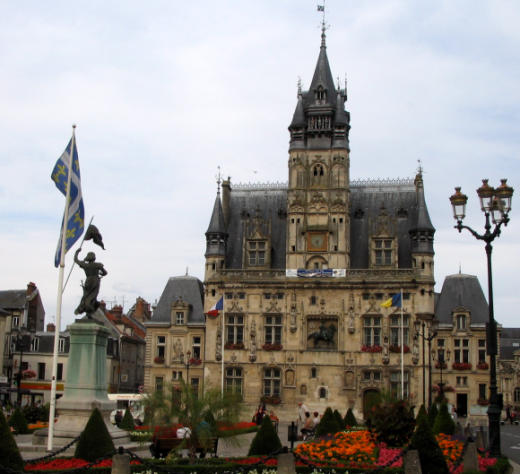
More eye-catching than the statue is the flamboyant façade of Town Hall, built at the turn of the 16th century. It is one of France’s most remarkable town halls for the way it represents the transition between Gothic and Renaissance architecture in the kingdom. Louis XII, who reigned 1498-1515, rides at the center. (The Loire Valley cyclist might recognize him from the entrance to the Castle of Blois.) Town Hall’s Bancloque, an ancient bell first installed in 1303, still manages a dull thud and dong. The Compiegne Tourist Office is here. If you don’t yet have a map of cycling routes for this daytrip you can pick one up here, along with a town map and other information.
As far as tourism goes, though, the palace is the town’s main attraction.
The Palace of Compiegne
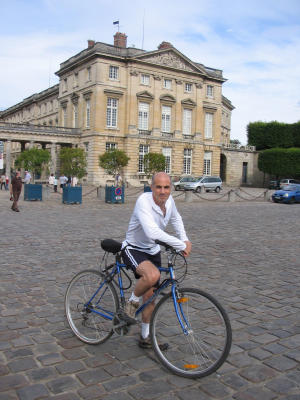
Successive royal castles existed here since the 5th century, beginning with the earliest dynasty of rulers, the Frankish Merovingian kings. What’s seen today is a royal and imperial palace that began with a complete redesign and rebuilding in the latter half of the 18th century by Louis XV’s chief architect Ange-Jacques Gabriel. Gabriel’s other major works include the Petit Trianon and the Opera at Versailles, Place de la Concorde and adjacent Hôtels de Crillon and de la Marine in Paris, and Place de la Bourse in Bordeaux.
The Palace of Compiegne as it stands today is a major monument to the architectural style of the latter part of Louis XV’s reign (1715-1774) and to decorative styles over the 100 years that followed.
On our last biking excursion we didn’t go inside but we did stop to watch a parade by the palace.
Here, in 1770, Louis XV’s grandson and heir to the throne, the 16-year-old future Louis XVI, was first introduced to his fiancé Marie-Antoinette of Austria. It wasn’t the kings Louis who got the most use from the palace, however (they continued to primarily hold court at Versailles), rather the emperors Napoleon. In 1810, Napoleon I met his second wife, Marie-Antoinette’s niece Marie-Louise, at Compiègne, but the first Napoleon generally preferred Fontainebleau.
Compiègne is primarily associated with lengthy stays by Napoleon III, who reigned 1852-1870, and his imperial court. When not reigning from the Tuileries Palace in Paris, this was his Versailles, where he would gather the Court for a month or more during the autumn hunting season in the forest that you’ll soon be biking through.
If the weather turns sour while in Compiegne, you can always forgo biking and spend the afternoon visiting the palace and the town.
Warning: If you do lock up your bikes outside and decide to take a quick tour of the palace, you may soon fall under its charms and find yourself drawn into spending a few hours here: visiting palace rooms that give an excellent lesson in the decorative styles associated with the eras of Louis XV and XVI and Napoleon I and III; strolling in the park; lounging in the tearoom; visiting a museum dedicated to the Second Empire (Napoleon III) and then a large collection of horse-drawn carriages and vehicles from the 17th to the 20th centuries, including early motorized vehicles and bicycles. A biking daytrip can soon turn into an excursion to the Palace of Compiegne.
Entrance to the park is free if you’d just like to lock your bikes up outside to enjoy an impressive view the palace from that side. But if the weather holds and you still think of this as a biking excursion, either limit your time in the palace or save your Compiegne-only daytrip for another day. Then cycle on past the palace, down Avenue Royale, with stately mansions to your right and a horseracing track coming up on your left.

The Castle of Pierrefonds
At a leisurely pace with a village stop along the way you’ll arrive in Pierrefonds an hour or two later. Or you could get lost, as a friend and I did on a distracted trek through the woods, and nonchalantly arrive three hours later.
As with the Palace of Compiegne, you can lock up your bikes to go inside the Castle of Pierrefonds, or not. Since there’s less to see inside, the interior can be visited in less than an hour. From Jan 11-Sept. 16, 2018 there’s an exhibition of castle graffiti, particularly during the First World War, when the castle was requisitions to house French soldiers.
Here’s a drone view of the castle:
The feudal castle of the late 14th century was mostly dismantled in the 17th, leaving ruins to be admired by the likes of Victor Hugo and others who enjoyed exercising their imaginations of medieval time. Among them was the architect Eugène Viollet-le-Duc, the man behind many of the state-sponsored restorations of the reign of Napoleon III. The emperor’s affection for Compiegne and for hunts in the forest would have led him along some of the same paths that just brought you to Pierrefonds. He commissioned Viollet-le-Duc to rebuild the castle, and the architect was pleased to have such an open hand in creating an idealized fortified castle, drawbridge (currently under restoration) and all. While not authentically medieval, it is nevertheless an imposing sight standing on a hill above this quaint little town of about 1860 Pétrifontains, as its inhabitants are called.
Whether entering the castle or not, this daytrip calls for a relaxing pause in a café by the town square below it or by the lake.
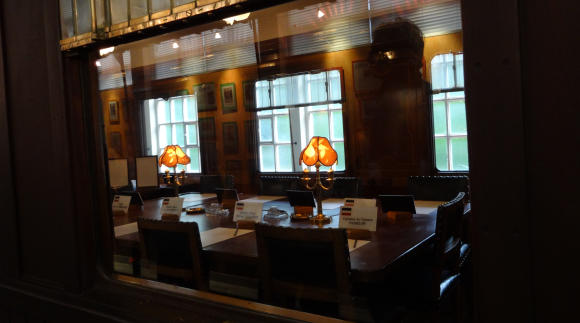
The Glade of the Armistice
A stop at the Glade of the Armistice (Clairière de l’Armistice) adds just three miles to the ride back to the Compiegne train station. Be sure to have a detailed map of the forest so as to not miss the point at which you’ll break off from the main Pierrefonds-Compiegne biking route to head to the Clarière.
In addition to the three extra miles, count on 30 to 60 minutes to visit this reminder of the armistice ending combat of the First World War and of the French surrender ending the Battle of France in the initial phases of the Second World War.
A dining car put into service in 1914, shortly before the start of the war, was placed at the disposal of French Marshal Ferdinand Foch, Supreme Allied Commander in 1918, and brought on November 8 of that year to the Rethondes railway junction in a secluded clearing on the edge of the forest. It was here that Foch and British First Lord of the Admirality Rosslyn Wemyss, together representing the victorious Allies, met with Matthias Erzberger, who led the German delegation, for the purpose of agreeing to an signing an armistice to end combat after more than four years of war. The signing took place three days after the parties first met, with the armistice set to take effect “at 11 o’clock, on the 11th day, of the 11th month.”
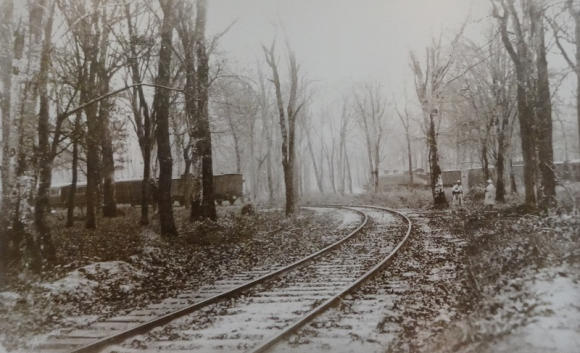
The original railway car was presented in the courtyard of the Invalides in Paris from 1922 to 1927 before being placed back in the glade in the forest.
It was in this same clearing in that same car that Adolf Hitler delighted in having France surrendered to Germany on June 22, 1940. The car was then taken to Germany to be proudly displayed in Berlin. It was moved again later in the war to protect it from aerial bombing, but nevertheless went up in flames in 1945. Whether the fire was due to a bombing raid or by intentional German destruction is debated. The museum here itself states that the fire was “accidental.” A replica of the wagon as it was on November 11, 1918, now stands in the clearing, along some original monuments from the 1920s, including a statue of Marshal Foch. A small museum recounts these events through photographs and artefacts.
The last train to Paris
The last train to Paris from Compiegne generally departs at about 8:30PM.
© 2018, Gary Lee Kraut
For further information see the following websites:
Picardie Forêts Vertes (Compiegne bike rental company), Vélotic (Compiegne bike share), Forest of Compiegne biking map, Compiegne Tourist Office, Palace of Compiegne, Castle of Pierrefonds, Glade of the Armistice, SNCF train schedule and reservations. Compiegne and Pierrefonds are within the department (sub-region) of Oise.


Francis Poulenc based his opera “Les Dialogues des Carmélites” on the true story of the 13 nuns of the convent at Compiegne and what happened to them during the Revolution. It’s a harrowing tale…and it precipitated the end of not only the Reign of Terror but the Revolution itself. Another little known fact is that one of Louis XV’s sisters was a nun in that convent but died prior to the Revolution.
Excellent commentary and writing. As always, you understand my obsession with the Bicycle Your France Guidebook series.
Thanks, Walter. It’s part of my Bicycle My France Revisited series.